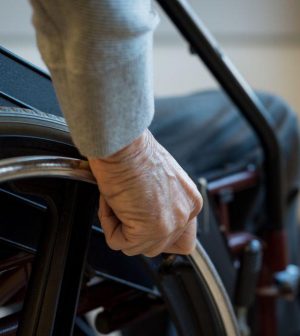- Navigating Your Midlife Crisis: Embracing New Possibilities
- City Raccoons Showing Signs of Domestication
- Mapping the Exposome: Science Broadens Focus to Environmental Disease Triggers
- One Week Less on Social Media Linked to Better Mental Health
- Your Brain Changes in Stages as You Age, Study Finds
- Some Suicide Victims Show No Typical Warning Signs, Study Finds
- ByHeart Formula Faces Lawsuits After Babies Sickened With Botulism
- Switch to Vegan Diet Could Cut Your Greenhouse Gas Emissions in Half
- Regular Bedtime Does Wonders for Blood Pressure
- Dining Alone Could Mean Worse Nutrition for Seniors
Spinal Cord Injury Triggers Muscle Wasting, Study Finds

A spinal cord injury can trigger muscle wasting in patients, causing them to drop more weight and muscle mass than can be explained solely by their paralysis, a new study in mice warns.
This muscle wasting is rapid and severe, and it appears to be linked to a hormone imbalance caused by the injury, researchers said.
Specifically, it depends on whether a person’s adrenal glands lose their ability to receive nerve signals following a spinal cord injury along a person’s upper spine, researchers said.
This phenomenon could explain why relatively thin patients have a much higher risk of death following a spinal cord injury, said researcher Dr. Jan Schwab, a professor of neurology at the Ohio State University College of Medicine.
“With a better understanding of this muscle wasting and aggravated weight loss, we hope to explore new ways to reduce deaths in this fragile patient population,” Schwab said in a university news release.
When the adrenal glands are deprived of nervous system control, the body becomes flooded with excess levels of the stress hormone cortisol, researchers found.
“This hypercortisolism then acts on specific receptors in the muscle of the entire body to cause muscle loss,” said lead researcher Markus Harrigan, a member of Schwab’s research lab and Ohio State’s dual-degree MD-PhD Medical Scientist Training Program.
“Interfering with this pathway could rescue muscle tissue and improve the response to rehabilitation,” Harrigan added.
The study, published Dec. 20 in the journal Science Translational Medicine, builds on previous Ohio State research into the effects of a spinal cord injury on the immune system. These injuries tend to suppress the immune system and increase a person’s risk of infections.
“We now start to understand how an injury of the spinal cord leads to spinal cord disease affecting the entire body,” Schwab said. However, research in animals doesn’t always pan out in humans.
“Our future research will search for ways to block these complications and protect the adrenal gland from receiving ‘false’ autonomic nervous system information originating from the spinal cord below the lesion site,” Schwab continued.
More information
The National Institutes of Health has more on spinal cord injuries.
SOURCE: Ohio State University, news release, Dec. 20, 2023
Source: HealthDay
Copyright © 2025 HealthDay. All rights reserved.










